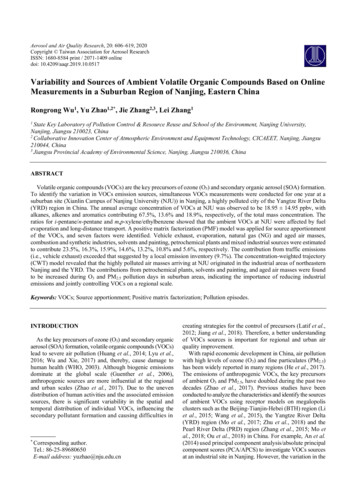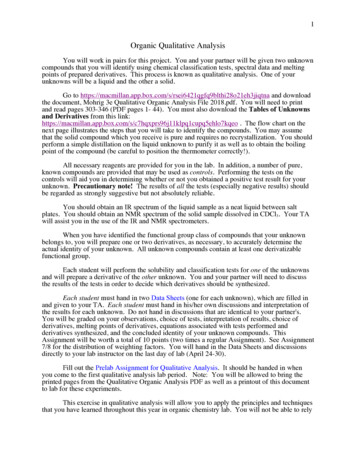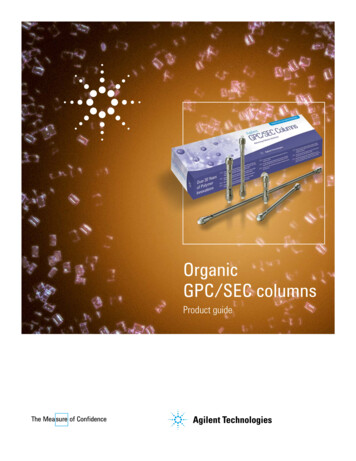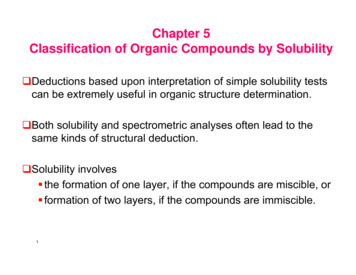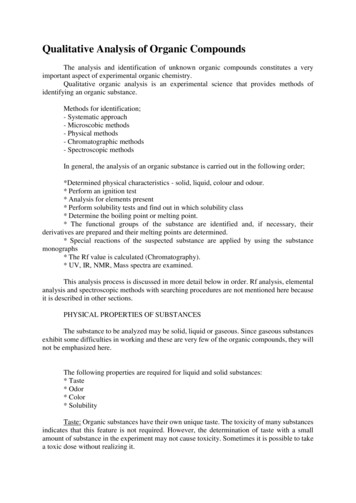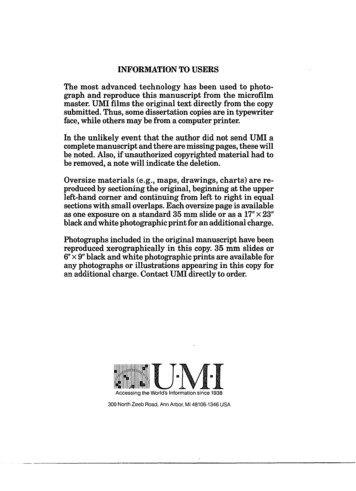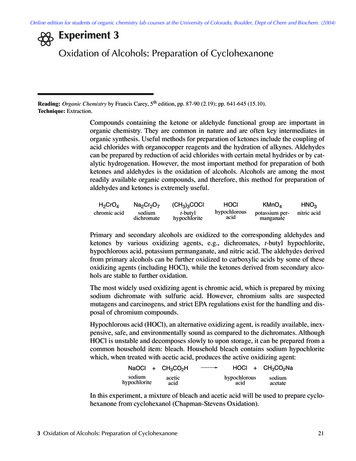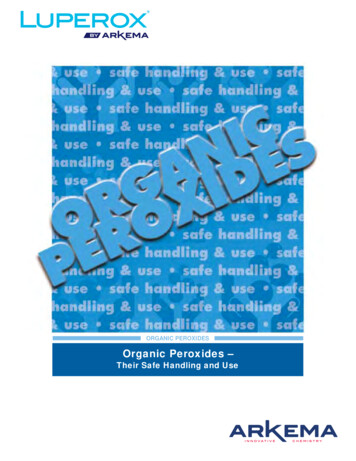
Transcription
ORGANIC PEROXIDESOrganic Peroxides –Their Safe Handling and Use
TABLE OF CONTENTSSECTION1PAGE1Introduction22Safety Guidelines/Sources of Hazard33Hazard Information44Description of Various Product Classes tation129First Aid1210Safety Check List1311Conclusion14INTRODUCTIONThe purpose of this bulletin is toprovide information on the safehandling and use of organic peroxides.Chemically, organic peroxides arecompounds characterized by the presence of an oxygen-oxygen linkage inthe molecular structure.9Organic peroxides are sensitive to heatand contamination, since these conditions will cleave the oxy-oxy bonds toform free radicals.2Since organic peroxides are reactivechemicals, they can be dangerous ifmistreated or mishandled.In case of Emergency call –Chemtrec: 800-424-9300For Medical Assistance call –R.M.P.C.C.: 303-623-5716(Rocky Mt. Poison Control Center)SAFETY GUIDELINES/TYPESOF ORGANIC PEROXIDESA wide variety of organic peroxidesare now offered commercially to meetthe sophisticated needs of polymermanufacturers. Among them areperoxyesters, peroxydicarbonates,dialkyl peroxides, diacyl peroxides,hydroperoxides, peroxyketals andMEK peroxides. Products representing each of these classes are listed inTable 1. (Note: MEK or Ketone peroxides are a mixture of peroxides andhydroperoxides).There are differences in the degreeand type of hazard associated withthese peroxides. A series of tests hasbeen carried out to evaluate properties such as shock sensitivity, heatsensitivity, burning rate, flash pointand storage stability. The results ofthe tests have proven helpful inestablishing safe handling, storageand disposal guidelines, and in developing the packaging and shippingprocedures described in this bulletin.Table 1 Representative organic peroxidesPeroxyestersOPeroxydicarbonatesODialkyl PeroxidesODiacyl x P(t-Butylperbenzoate)Luperox 223-M75S(Di-2-ethylhexylperoxydicarbonate)Luperox DI(Di-t-Butyl peroxide)Luperox A98(Benzoyl peroxide)Luperox TBH70X(t-Butyl hydroperoxide)Luperox 231(1,1-Di(t-Butyl peroxy)3,3,5-trimethylcyclohexane)Luperox DDM-9(MEKP Solutionin Plasticizer 9% Active Oxygen)Luperox 26(t-Butyl peroctoate)Luperox 225-M60S(Di-sec-Butylperoxydicarbonate)Luperox 1012,5-dimethyl-2,5-bis(t-Butyl-peroxy) hexaneLuperox LP(Lauroylperoxide)Luperox CU90(Cumenehydroperoxide)Luperox 331M801,1-Di(t-Butyl peroxy)cyclohexaneLuperox Delta-X9(MEKP Solutionin Plasticizer 9% Active Oxygen)Luperox 11M75(t-Butylperoxypivalate)Luperox DC(Dicumyl peroxide)Luperox 10M75(t-Butyl peroxyneodecanoate)Luperox F(2,2-bis (t-butyl peroxy)diisopropylbenzene(s))Note: Lupersol DDM-9*, DHD-9*, DDM-30* and Delta X-9* will change to Luperox and drop * during 2001. Formulations will not change.2Ketone PeroxidesLupersol and Luperox are registered trademarks of Arkema Inc.Luperox DHD-9(MEKP Solutionin Plasticizer 9% Active Oxygen)Luperox 224(2,4 PentanedionePeroxide Solutionin Plasticizer)
HAZARDS INFORMATIONThe major causes of peroxidedecomposition (sources of hazard)are Heat, Fire, Friction, Shock andContamination. Examples of thecommon sources of these include:HAZARD OVERVIEWTEMPERATURE3DangerZoneself heatingHeat - Sunlight; loss of refrigeration;radiators; heating elements; hotreaction vessels; heating ducts.Fire - Open flame; sparks.Friction - Mixing; pumping; grinding;traffic over spillage (which cangenerate heat).Shock - Dropping; impact duringtransportation (which can generateheat).Contamination - Metal salts; amines;acids; bases; polymerization accelerator; transition metals; persulfates.The major safety characteristicsArkemaInc.measurestodetermine the relative hazard of anorganic peroxide include: shocksensitivity, the amount of energyreleased during a decomposition,and flash point. Also measured arethe ease of burning, sensitivity to rateof heat rise, thermal stability, selfaccelerating decompostion temperature and ignition or autoignitioncharacteristics.STANDARD SAFETY TESTSStandard tests have been developedfor determining the hazard of peroxides. The following is a list anddescription of these established tests:A. SADT (Self AcceleratingDecomposition Temperature)The SADT test establishes thelowest temperature at which aperoxide, in its largest commericalpackage, will undergo self accelerating decomposition. The type ofdecomposition and damage potential are measured, and the severityof decomposition is determined.The two parameters having theRedZoneSADTviolentdecompositionIncreased Assay Loss ZoneRecommendedStorageTemperatureSafe ZoneTIMEFigure 1greatest effect on SADT are rate ofdecomposition and heat loss fromthe package. Figure 1 illustrates theimpact of the SADT.B. Shock SensitivityA standard weight is dropped on asmall sample in an “impact tester”.The height of the fall required for theweight to decompose the productis a measure of its sensitivity toshock. Dry/pure Dibenzoyl peroxide(Luperox A98) is one of the fewcommercially available peroxides toexhibit shock sensitivity in this test.C.Flash PointThe standard (closed cup) SETAflash test is now used. It is thetemperature at which the productvapors ignite on contact with anopen flame.D.Thermal Stability TestResults are determined by storingperoxide at a constant temperaturefor a specified time. The results ofthis test in terms of weight loss andassay are used as criteria for establishing storage temperature andshelf life requirements.Product descriptions and safetydata for representative organicperoxide formulations are givenin tables 2 and 3.The three primary types of hazards to beconcerned with are flammability, heat sensitivity and contamination.The following statements are providedas general discussion for these typesof hazards, as they relate to all organic peroxides.A. FlammabilityAll organic peroxides will burn vigorously,and once ignited will be difficult to extinguish.The flammability of organic peroxides willalso be affected by the decompositionproducts. When most peroxides begin todecompose they will generate vapors andheat. Such vapors may be flammable andcould be the cause of an explosion.B. Heat SensitivityAll organic peroxides are sensitive to heat. Ifa peroxide is heated above a certaintemperature (depending on the specificheat sensitivity of the peroxide itself) therate of decompostion will increase in anuncontrolled manner. This reaction canbecome violent, releasing large volumes ofhot, flammable gasses.The temperature at which this will occurdepends on the volume of the peroxide,the container and the period of timethe peroxide remains at that temperature.The self accelerating decompositiontemperature (SADT) test provides ameasure of this hazard.In general, the best way to avoid decomposition due to heat is to scrupulouslyadhere to the recommended storagetemperatures for each product. This isparticularly true for peroxides requiringrefrigerated storage.C.ContaminationChemical contamination can acceleratedecomposition of organic peroxides.Care should be taken to avoid all formsof contamination, particularly oxidizingand reducing agents and metal salts –especially strong mineral acids. Thesewill initiate a rapid decomposition atnormal ambient temperatures, whilemany heavy metals such as copper, iron,brass, etc. will have a similar effect over alonger period of time.3
Liquid MixtureLiquidLiquidSolid MixtureLiquidDi-t-butyl Peroxidet-butyl Hydroperoxidet-butyl Hydroperoxidet-amyl peroxyacetatet-amyl peroxybenzoateDi-t-amyl Peroxide2,5-Dimethyl 2,5 -Di(t-butylperoxy) hexyne-32,5-Dimethyl 2,5 -Di(t-butylperoxy) hexyne-32,5-Dimethyl 2,5 -Di(t-butylperoxy) hexaneLuperox TBIC M75Luperox DILuperox TBH 70XLuperox TBH 70Luperox 555M60Luperox TAPLuperox DTALuperox 130Luperox 130XL45Luperox 101PlasticizerLiquidLiquid MixtureLiquid MixtureLiquid MixtureLiquidLiquid MixtureLiquidLiquid MixtureLiquid quid MixtureLiquid BBP & fillerBBP & FillerDBP & eNAAromatic 100OMSOMSDiluentLiquid MixtureLiquid MixtureLiquidLiquidLuperox TAECCatalyst 730*Luperox CU90Red Catalyst 11*Clear Catalyst 11*Luperox Delta X-9 (red)Luperox DHD-9 (red)Luperox DDM-30 (red)Luperox DDM-9 (red)Luperox 224Paste MixtureLiquid MixtureLiquid MixtureLiquid MixtureLiquid Mixturet-butylperoxy isopropylcarbonateLuperox ACP35Luperox PLuperox PAR70Luperox 7M75Luperox 7M50Paste MixtureLuperox TBECDibenzoyl PeroxideLuperox ATC50Paste MistureLiquidDibenzoyl PeroxideLuperox AFR40SolidSolidSolidSolid USP GradeSolid USP GradePaste MixturePaste Mixturet-butyl peroxy-2ethylhexyl carbonateDilauroyl PeroxideDibenzoyl PeroxideDibenzoyl PeroxideDibenzoyl PeroxideDibenzoyl PeroxideDibenzoyl PeroxideDibenzoyl PeroxideLuperox LPLuperox A98Luperox A75Luperox A75FPLuperox A70SLuperox ANS55Luperox ANS55PPhysicalFormDibenzoyl Peroxidet-Butyl Perbenzoatet-Butyl Perbenzoatet-Butyl peroxyacetatet-Butyl peroxyacetate2,4 PentanedionePeroxideMethyl Ethyl KetonePeroxideMethyl Ethyl KetonePeroxideMethyl Ethyl KetonePeroxideMethyl Ethyl KetonePeroxideMEKP & CumeneHydroperoxideMEKP & CumeneHydroperoxideMEKP & CumeneHydroperoxideCumene Hydroperoxidet-amyl peroxy-2ethylhexyl carbonatePeroxideNameTradeNameTable 2 Ambient Products & Safety Data91 to 93%45%90 to 95%96%95%60%70%70% 98%75%95%91%35%98%70%75%50%4% ActiveOxygen9% ActiveOxygen5.5% ActiveOxygen9% ActiveOxygen9% ActiveOxygen8.6% ActiveOxygen (min)8.6% ActiveOxygen (min)8.7% ActiveOxygen (min)88 to 90%50%40%98.50%98%75%75%70%55%55%Assay (%)38 C/100 F38 C/100 F38 C/100 F38 C/100 F38 C/100 F38 C/100 F38 C/100 F38 C/100 F38 C/100 F38 C/100 F(prefer 85 F)38 C/100 F(prefer 85 F)38 C/100 F38 C/100 F38 C/100 F(prefer 85 F)38 C/100 F38 C/100 F38 C/100 F38 C/100 F38 C/100 F38 C/100 F38 C/100 F38 C/100 F38 C/100 F38 C/100 F38 C/100 F38 C/100 F(prefer 85 F)38 C/100 F38 C/100 F27 C/80 F38 C/ 100 F38 C /100 F38 C /100 F38 C/100 F38 C/100 F38 C/100 FMax. StorageTemp F (C )SADT86 C [30# ctn.]88 C [100# ctn.]93 C [35# ctn.]75 C [30# ctn.]65 C [40# ctn.]75 C [35# ctn.]est. 88 C [35# ctn.]est. 88 C [35# ctn.]80 C (30#ctn)65 C (35#ctn)65 C(35#ctn)65 C (35#ctn)NE82 C (5 gal. ctn)NENE85 C (8#ctn)85 C (8#ctn) 85 C (8#ctn)75 C (45# ctn)54 C(42#ctn)NE63 C (40# ctn)est 63 C (40# ctn)79 C (7#ctn)85 C (7#ctn)NE55 C (40# CTN)51 C (65#ctn)68 C (1#ctn.)71 C (25# ctn)71 C (25# ctn.)82 C (50# ctn)54 C (50# ctn)54 C (50# FPA Code704 HealthHazard PA Code704 Flamm.Hazard PA Code704 ReactivityHazard ID.III (30 gal.)NENENEII(5 gal.)III(5 gal.)II (55 gal.)IV (55 gal.)III (55 gal.)II (5 gal.)III (5 gal.)NENEIII (55 gal.)NENE(V 5 gal. lb.)IV (5 gal.)for DMP prodIV (5 gal.)for DMP prodIV (5 gal)for DMP prodIV (5 gal.)for DMP prodV (100 lb.)II (5 gal.)NEI (5 gal.)NENEIV (380 lb.)IV (110 lb.)I (1lb.)III (25 lb.)III (25 lb.)IV (25 lb.IV (350 lb.)IV (350 lb.)NFPA Code432 StorageClass3HAZARDS INFORMATION
Solid MIxtureSolid iquid uid Mixture2,5-Dimethyl 2,5 -Di(t-butylperoxy) hexane2,5-Dimethyl 2,5 -Di(t-butylperoxy) hexaneDi-2-t-butylperoxyisopropyl benzeneDi-2-t-butylperoxyisopropyl benzeneDi-2-t-butylperoxyisopropyl benzeneDi-2-t-butylperoxyisopropyl benzeneDi-2-t-butylperoxyisopropyl benzeneDicumyl PeroxideDicumyl PeroxideDicumyl PeroxideDicumyl PeroxideDicumyl Peroxide1,1 Di(t-amylperoxy)cyclohexaneEthyl 3,3 di- t-amylperoxy butyrate1,1 di-t-(butylperoxy3,3,5 trimethylcyclohexane1,1 di-t-(butylperoxy3,3,5 trimethylcyclohexane1,1 di-t-(butylperoxy3,3,5 trimethylcyclohexanen-butyl 4,4 bis t-butylperoxy valeraten-butyl 4,4 bis t-butylperoxy valerateEthyl 3,3 di- t-butylperoxy butyrate1,1 Di(t-butylperoxy)cyclohexaneLuperox HP101XLPLuperox 101PP20Luperox FLuperox F40PLuperox F40KELuperox F40KEPLuperox F40MGLuperox DCSCLuperox DC40PLuperox DC40KELuperox DC40KEPLuperox DC40MGLuperox 531M80Luperox 533M75Luperox 231Luperox 231P75Luperox 231XL40Luperox 230XL40Luperox 230Luperox 233M75Luperox 331M80OMSOMSNACalcium CarbonateCalcium CarbonatePhthalateNAOMSOMSEPM RubberClayClayCalcium CarbonateNAEPM reCalciumCarbonate80%75%95 - %20%45%32 C /90 F38 C /100 F38 C /100 F38 C /100 F32 C /90 F32 C /90 F32 C /90 F32 C /90 F32 C /90 F38 C /100 F38 C /100 F38 C /100 F38 C /100 F38 C /100 F38 C /100 F38 C /100 F38 C /100 F38 C /100 F38 C /100 F38 C /100 F38 C /100 F38 C /100 FNE 65 C [35# cnt]for phthalate blend80 C [35# ctn.]75 C [40# ctn.]60 C [20# ctn.]60 C [100# ctn.]est. 66 C [35# ctn.]66 C [35# ctn.]80 C [35# ctn.]60 C [30# ctn.]NENENENE91 C [40# ctn.]NENENENENEest. 82 C [100# ctn.]est. 82 C [100# ctn.]82 C [100# 1112NENE1NOTE: Lupersol DDM-9*, DDM-30*, DHD -9* and Delta X-9* trade names are scheduled to change to those indicated in the table during 2000 or 2001. PRODUCT FORMULATIONS WILL NOT CHANGE.SolidSolidSolid Mixture2,5-Dimethyl 2,5 -Di(t-butylperoxy) hexaneLuperox 101XL45322NE13322NE1112NE0002NENE1II(5 gal.III(5 gal.)II (5 gal.)NEV(100 lb.)II(5 gal.)II(5 gal.)III(5 gal.)III(5 gal.)NEV(100 lb.)V(100 lb.)V(100 lb.)IV(55 gal.)NEV(100 lb.)V(100 lb.)V(100 lb.)III (100 lb.)NENEV (100 lb.)
Table 3 Arkema Inc. Refrigerated say (%)Luperox SAPsuccinic acid peroxide2-Hydroxy-1, 1-dimethylbutylperoxyneodecanoatet-amyl peroxy -2-ethylhexanoatet-amyl peroxy -2-ethylhexanoateFrozen SolidWater57.29Liquid Mixtu
and flash point. Also measured are the ease of burning, sensitivity to rate of heat rise, thermal stability, self accelerating decompostion tempera-ture and ignition or autoignition characteristics. STANDARD SAFETY TESTS Standard tests have been developed for determining the hazard of perox-ides. The following is a list and



